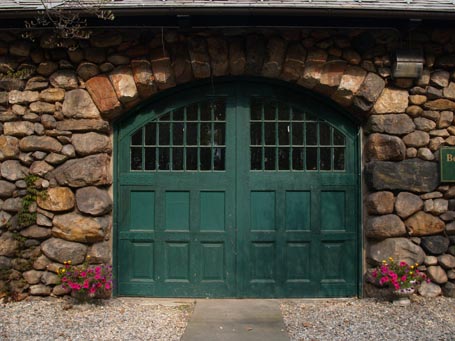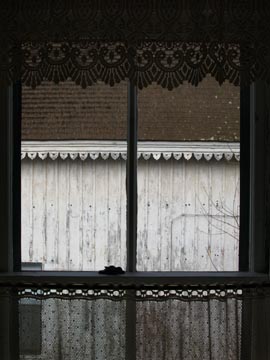
Entries from April 1, 2008 - April 30, 2008
Design snapshot: Classic carriage-house doors
 Perhaps these old doors once provided access to horse-drawn carriages. Nowadays they’re inactive. Time has taken a toll. A row of raised panels has been replaced with flat-panel substitutes. The astragal trim, which would have covered the vertical intersection between the joining door leaves, is missing. The hinges appear unhinged. Nonetheless, they’re handsome doors.
Perhaps these old doors once provided access to horse-drawn carriages. Nowadays they’re inactive. Time has taken a toll. A row of raised panels has been replaced with flat-panel substitutes. The astragal trim, which would have covered the vertical intersection between the joining door leaves, is missing. The hinges appear unhinged. Nonetheless, they’re handsome doors.
Natural light enters the narrow, glass panes that are in careful proportion with the wood panels. View of the interior is purposefully limited since this would originally have been a storage space. The hefty, field stone, exterior wall with deeply raked joints and arched top greatly contributes to the appeal. The warm toned stone nearly complements the forest green doors, in much the same way that cedar shingles would often offset dark green trim when the Shingle style had its heyday.
There’s plenty here to inspire the design of oversized doors today -- for a garage, carriage house, or creative outbuilding. Attention to detail never goes out of favor.
by Katie Hutchison for the House Enthusiast
Slow food inspires Slow Home
 I only recently discovered Slow Home thanks to architect Bob Swinburne of Vermont. In a video introduction Founding Editor John Brown (an architect, real estate broker and Professor of Architecture at the University of Calgary) describes Slow Home as “a new design environment that will help you learn about Modern residential design and how to start integrating the principles of good design into your daily life.”
I only recently discovered Slow Home thanks to architect Bob Swinburne of Vermont. In a video introduction Founding Editor John Brown (an architect, real estate broker and Professor of Architecture at the University of Calgary) describes Slow Home as “a new design environment that will help you learn about Modern residential design and how to start integrating the principles of good design into your daily life.”
The site has a number of informative features that illuminate the rewards of good design and the failures of ill-considered design. The Design Studio category includes telling segments titled “What’s Wrong With This House?” in which Brown provides voice-over analysis and recommendations for drawings that he shares via video. The News category includes both pithy clips from other media sources and Slow Home announcements that pertain to residential discourse, events, and updates. For a quick overview of what to expect on the site for a given week check out the Slow Home Report videos.
Though the aesthetic of the work featured on the site is Modernistic, I don’t believe the thinking behind the Slow Home movement need be strictly associated with a specific style. Their site states, “In the same way that slow food raises awareness of the food we eat and how these choices affect our lives, Slow Home provides design focused information to empower each of us to take more control of our homes and improve the quality of where and how we live.” I believe such information could empower readers to pursue authentic design, no matter their aesthetic preferences.
by Katie Hutchison for the House Enthusiast
My first small retreat
 This is my childhood playhouse out behind the Connecticut farmhouse where I grew up. My parents think it may have originally been a corncrib. Here, it’s looking its finest, once my mother made it her own after I was grown.
This is my childhood playhouse out behind the Connecticut farmhouse where I grew up. My parents think it may have originally been a corncrib. Here, it’s looking its finest, once my mother made it her own after I was grown.
She landscaped it with dwarf English boxwoods, applied a trellis, and planted geraniums in the flower boxes. A fresh coat of paint on the exterior spruced up the board siding and awning windows. She knew the weathered, white-washed interior would continue to charm as does the picket-edged detailing on the gable end. She equipped the interior with a dry sink, twig furniture, and small garden tools, supplanting my Easy-Bake Oven and miniature tea sets.
At different times, it was, for both of us, a dreamy retreat where we indulged in leisurely summer days, carefree imaginings, and everyday growing.
Do you have a small retreat that speaks to you? It may speak to others, so let me know if you’re interested in sharing it.
by Katie Hutchison for the House Enthusiast
Call for small-retreat submissions for publication
Today I’m embarking on a book project with The Taunton Press. I’ll be writing about appealing, small retreats – backyard and beyond. The featured retreats will be in the U.S. or Canada and will each be less than 750 square feet. They may include such uses as: an artist studio, beach pad, bunk house, pool cabana, tea house, writer’s shack, dining pavilion, summerhouse, garden folly, mountain escape, tree house, etc… Some will be antique retreats, some will be adapted from other uses, and some will be more recently created. I aim to illuminate how they collectively portray eight characteristics of good, small-retreat design, so readers can create their own special places.
If you know of a project that you think I should consider including in the book, please let me know. For now, simply email me (Katie@katiehutchison.com) some low resolution jpegs of the exterior, interior, and context, along with some background information about what it is, where it is, who owns it, who designed it, and if it has been professionally photographed. Also, please let me know if you’re aware of any architectural drawings that depict it and its site.
I’ll be collecting projects to consider for publication in the coming weeks and look forward to reviewing those that you may recommend. Together we can create an inspiring and informative book. Please join me.
by Katie Hutchison for the House Enthusiast
Design snapshot: Celebrating the edge
 Click on this photo to see it in the note cards/prints gallery.A lace, scalloped-edge valance echoes a unique, scalloped-edge eave on a board-and-batten barn. Ornamentation along an eave or window head can embellish such lines of transition, calling attention to them. Here, both the lace valance and carved eave detail enlist daylight as an accomplice. The partial transparency of the lace softens the window head, while, in bright sun, the shadow-line of the eave carving would highlight the intersection of the roof and wall. Accents such as these enhance edge conditions.
Click on this photo to see it in the note cards/prints gallery.A lace, scalloped-edge valance echoes a unique, scalloped-edge eave on a board-and-batten barn. Ornamentation along an eave or window head can embellish such lines of transition, calling attention to them. Here, both the lace valance and carved eave detail enlist daylight as an accomplice. The partial transparency of the lace softens the window head, while, in bright sun, the shadow-line of the eave carving would highlight the intersection of the roof and wall. Accents such as these enhance edge conditions.
by Katie Hutchison for the House Enthusiast















